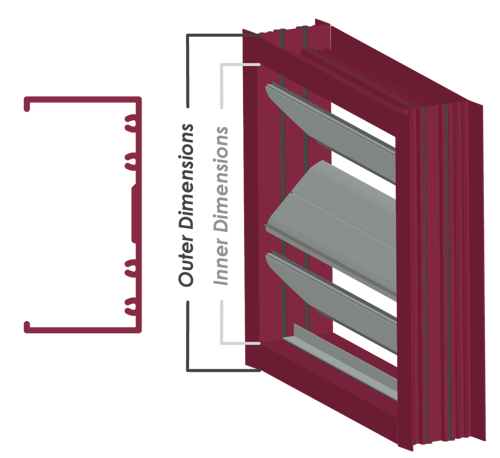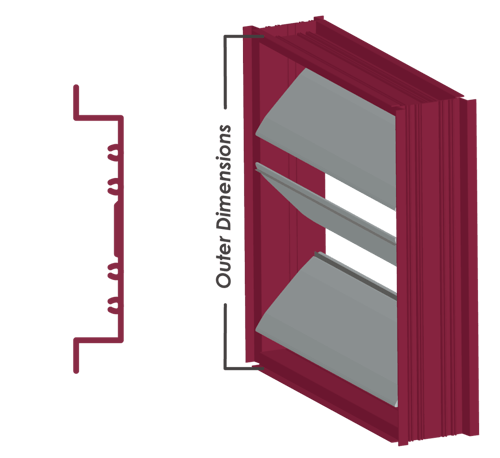Do you know how to size your control dampers? Learn to measure inner and outer dimensions and when to use which type of measurement. Find the best fit for control damper with the MCDLG Newsstand.
Sizing a damper seems like the easiest part of the selection process. You know the damper will go into a duct or a ventilation opening. If you know the size of the duct, then you should know the size of the damper. Right? This may not always be the case.
Inner and Outer Dimensions
Dampers can be mounted onto the opening or inside it. You can also install dampers to fit inside of ductwork or to match the duct. How you measure the damper's dimensions will depend on its frame. These installations will require different sizes. For the best fit, you need to know where to measure the damper’s dimensions.
All square and rectangular dampers are measured by height and width, while round dampers are measured by diameter. These measurements are taken from the outer dimensions or the inner dimensions. Where you measure will depend on the damper’s frame and where the damper will be installed.

The outer dimensions, or O.D., are measured along the perimeter of the frame. Manufacturers will typically reduce O.D. sizing by a ¼ inch, for height and width, to account for slight changes in the duct’s dimensions. If you need the exact dimensions, then you must specify exact sizing when ordering. Otherwise, the manufacturer will undercut the damper by default. Outer dimensions are taken for dampers that will be mounted inside the duct opening.
The inner dimensions, or I.D., are measured along the edges of the face of the damper. In other words, measurements are taken inside the damper’s frame. Manufacturers will always build I.D. dampers to the exact size. These measurements ensure the damper will fit onto the opening of the duct, so that the damper’s face covers the opening.
Remember, dampers are measured either by their inner dimensions or their outer dimensions. The dimensions you measure will depend on the damper’s frame and where it is installed. With that in mind, let’s discuss how to measure dimensions for each type of frame.
Need more information on dampers? Check out these Newsstand articles:
- Four Ways to Make Efficient Dampers
- Connecting Dampers and Multi-panel Assemblies
- Damper Blades, A Primer
- Five Types of Dampers and When To Use Them
Channel Frames

Where to measure: Depends on how you want to install it.
Channel frames are versatile when it comes to sizing. You can choose to measure a channel frame damper from its inner dimensions or its outer dimensions, depending on how you plan to install the damper. For example, you choose a channel frame damper to fit into a duct that is 24” high by 24” wide.
- If you plan to install the damper onto the face of the duct or opening, then you can choose to specify inner dimensions for the damper. The manufacturer will build the damper to the dimensions specified. Once built and shipped, you will have a damper that is 24” high by 24” wide. The damper will sit on the walls or duct, so that only its face covers the opening.
- If you plan to install the damper inside the duct or a ventilation opening, then you will want to specify the outer dimensions of the damper. The manufacturer will undercut the height and width of the damper by ¼ inch, to ensure it fits the duct. Once complete, you will have a damper that is 23¾“ wide by 23¾“ high. If you need the damper to be exactly 24” x 24”, then specify exact dimensions.
Hat-Shaped Frames

Where to measure: Measure the outer dimensions
Hat-shaped frames are named for the hat-shaped extrusions along their jambs. Because of these extrusions, hat-shaped frames must be measured from their outer dimensions. When sizing a hat-shaped frame, your measurements will be made along the perimeter of the damper. For example, a damper that is 18” wide by 22” high, with a hat-shaped frame, will be measured by its outer dimensions. These dampers are typically installed inside of ducts and openings, so that the full damper sits in the air stream. By default, the manufacturer will undercut the damper's dimensions by a ¼ inch. The completed damper will be 17¾” wide by 21¾” high unless you specify exact dimensions.
Flanged Frames

Where to measure: Measure the damper's base frame.
Flanged frames are frames with flange attachments installed on the face or rear of the damper. Flanges are flat, thin metal pieces that can be added to the head, sill, or sides of a damper’s frame. These accessories are meant to extend past the damper’s face to cover the seams of an opening. The size of the flanges is determined separately from the damper’s dimensions.
For dimensioning purposes, you will measure the base frame of the damper and not the flange pieces. If the flange frame uses a hat-shaped frame for its base, then you will measure the outer dimensions of the hat-shaped frame. If the damper uses a channel frame for its base, then you can measure from inner dimensions or outer dimensions.
Round Frames

Where to measure: Measure inner dimensions for on-face mounting, or outer dimensions for in-duct mounting.
For round dampers, you will need to determine the diameter of the damper’s face. You can measure this from the inside edge of the damper’s face or along the outer frame of the damper. In other words, you can measure a round damper from its inner dimensions or its outer dimensions.
As you can see from the image above, there is only a small difference between the inner dimensions and the outer dimensions. However, it's still important to measure the right dimensions. Your choice will depend on where you plan to install the damper. Like other O.D. dampers, the manufacturer will undercut the damper’s size by a ¼ inch unless you specify exact diameter.
Does your project use spiral ductwork for ventilation? Learn the benefits of using round dampers for these applications in "Round Dampers for Spiral Ducts".
Choosing the Right Dimensions
It is important to correctly size your dampers. Dampers that are too large for the duct will have to be sent back to the manufacturer for modification. That takes time and money to fix. Remember to measure the damper’s dimensions according to its frame and how it will be installed.
Always check the damper’s submittal first to confirm the damper’s frame type. The submittal will also display the damper’s minimum and maximum dimensions.
It's a lot to consider. To summarize:
- Outer dimensions (O.D.) are measured along the perimeter of the damper. These dampers are typically installed inside the duct or ventilation opening.
- Inner dimensions (I.D.) are measured inside the frame of the damper. I.D. dampers are typically installed onto the duct or on the ventilation opening.
- Channel frames are measured from I.D. or O.D., depending on where they are installed.
- Hat-shaped frames are measured from O.D., so that they fit inside the duct or within the opening.
- Flanged frames are measured from I.D. or O.D., depending on the base frame.
- Round frames are measured from I.D. or O.D., depending on where they are installed. There is a small difference between I.D. and O.D., but the difference is important.
Which damper type is most common in your projects? Do you find yourself using round dampers more than square and rectangular ones? Share your stories in the Comments section. MCDLG wants to know!
MCDLG & Continuing Education
Want to know more? MCDLG offers a free self-paced course on control dampers.
"An Introduction to Air Control Dampers" covers the basics of control dampers: what they do, where they go in an HVAC system, the principles that dictate their performance, and guidelines for installing and maintaining your control dampers.
Learn the basics of control dampers and earn continuing education credits at your own pace. Visit the MCDLG Campus Portal today!
.webp?width=91&height=70&name=MCDLG%20Logo%20(Resize).webp)
.webp)






